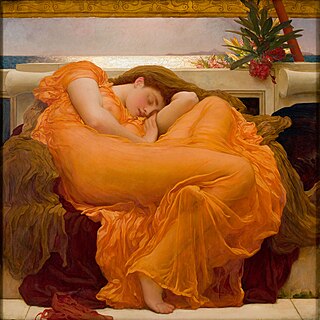Flaming June
| Flaming June | |
|---|---|
 |
|
| Artist | Frederic Leighton |
| Medium | Oil on canvas |
| Dimensions | 120 cm × 120 cm (47 in × 47 in) |
| Location | Museo de Arte de Ponce, Ponce, Puerto Rico |
Flaming June is a painting by Sir Frederic Leighton, produced in 1895. Painted with oil paints on a 47-by-47-inch (1,200 mm × 1,200 mm) square canvas, it is widely considered to be Leighton's magnum opus, showing his classicist nature. It is thought that the woman portrayed alludes to the figures of sleeping nymphs and naiads the Greeks often sculpted.
Flaming June disappeared from view in the early 1900s and was only rediscovered in the 1960s. It was auctioned shortly after, during a period of time known to be difficult for selling Victorian era paintings, where it failed to sell for its low reserve price of US$140 (the equivalent of $1,126 in modern prices). After the auction, it was promptly purchased by the Museo de Arte de Ponce in Ponce, Puerto Rico, where it currently resides.
Flaming June was first begun as a motif to adorn a marble bath in one of Leighton's other works, Summer Slumber. He became so attached to the design that he decided to create it as a painting in its own right.
The funereal solemnity of Michelangelo's monumental nude has been considerably warmed up, by the Victorian painter, in the act of appropriating and adapting it. Leighton has arranged matters in such a way that, although clothed, his somnolent girl's many charms are alluringly displayed for the delectation of the viewer – who is implictly put in the position of a voyeur... Her cheeks are flushed, reddened with a blush suggesting that somehow she knows she is being watched, even though she is sleeping.
According to art historian Andrew Graham-Dixon "her pose is loosely modelled on that of Michelangelo's famous statue of Night, in the Medici Tombs in Florence, which Leighton regarded as one of the supreme achievements of Western art." The position of the sleeping woman gave Leighton a great deal of trouble. He made several preliminary sketches to determine the way in which she should lie; in particular he had difficulty making the angle of her right arm look natural. His studies show that the picture went through at least four evolutionary sketches before Leighton came to the end result. Out of these studies, four are nude and one is draped. The draped figure looks the least lifelike, demonstrating Leighton's need to draw from a naked model to achieve a fidelity to nature.
...
Wikipedia
